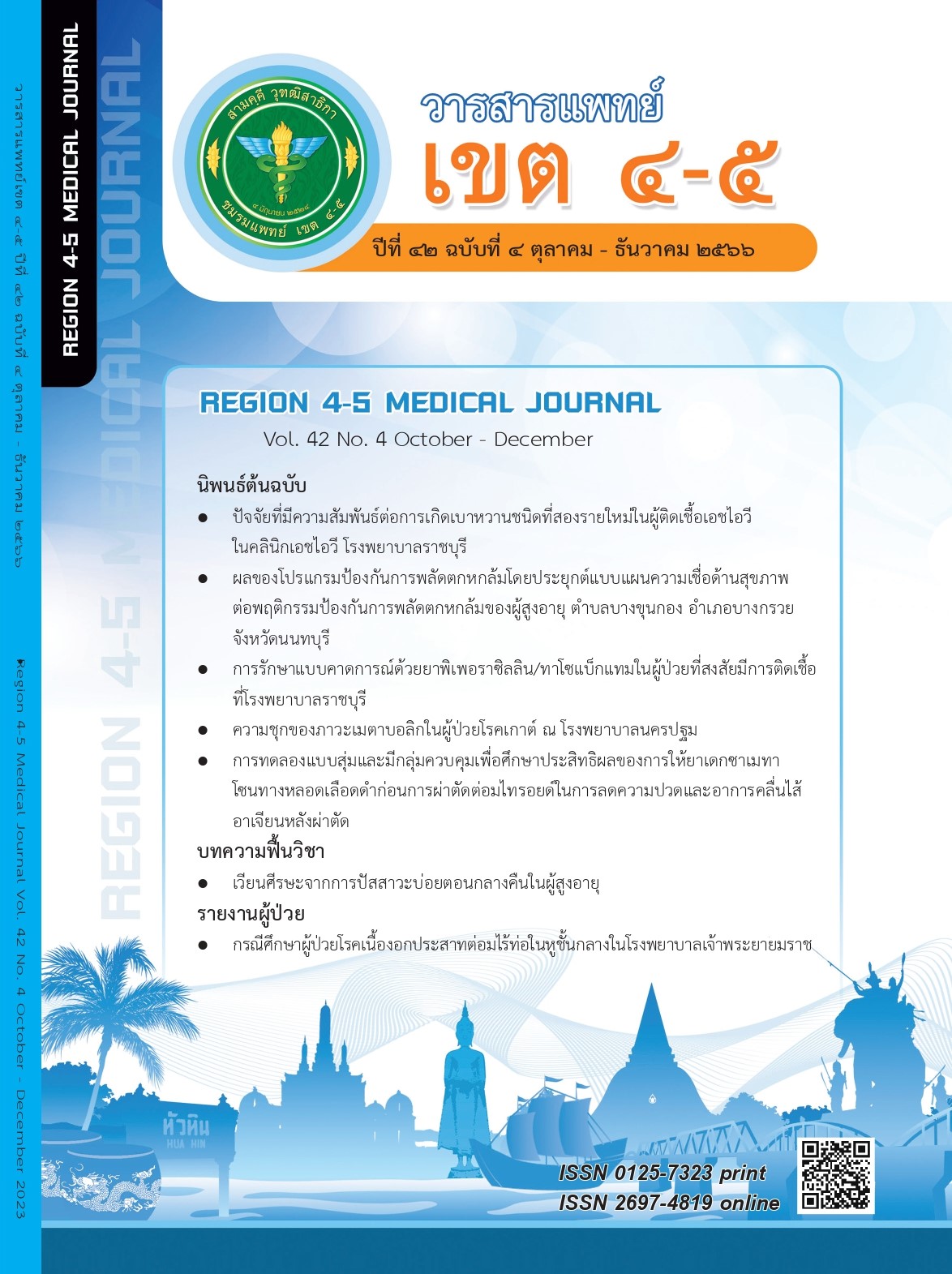ปัจจัยที่มีความสัมพันธ์ต่อการเกิดเบาหวานชนิดที่สองรายใหม่ ในผู้ติดเชื้อเอชไอวี ในคลินิกเอชไอวี โรงพยาบาลราชบุรี
คำสำคัญ:
เอชไอวี, เบาหวาน, ยาต้านไวรัส, ปัจจัยเสี่ยงบทคัดย่อ
วัตถุประสงค์: เพื่อศึกษาปัจจัยที่มีความสัมพันธ์ต่อการเกิดเบาหวานชนิดที่สองรายใหม่ ที่พบในผู้ติดเชื้อเอชไอวี ในโรงพยาบาลราชบุรี
วิธีการ: ผู้ป่วยติดเชื้อเอชไอวี แบ่งเป็น กลุ่มผู้ป่วยที่เกิดเบาหวานชนิดที่สองรายใหม่ 75 ราย และกลุ่มที่ไม่เกิดเบาหวาน 75 ราย โดยเก็บข้อมูลจากเวชระเบียนของผู้ป่วยที่เข้ารับการรักษาในคลินิกเอชไอวี โรงพยาบาลราชบุรี ตั้งแต่เดือนมกราคม พ.ศ. 2552 ถึง สิงหาคม พ.ศ. 2562
ผลการศึกษา: มีผู้ป่วยที่เกิดเบาหวานชนิดที่สองรายใหม่ 91 ราย คิดเป็นอัตราการเกิด 6.6 ต่อ 1,000 คน/ปี จากการวิเคราะห์แบบพหุตัวแปร พบว่าอายุที่เพิ่มขึ้น มีโอกาสเกิดเบาหวานมากขึ้น 1.11 เท่า, ภาวะอ้วนมีโอกาสเกิดเบาหวานมากกว่า 4.10 เท่า, ผู้ที่ได้รับยา statin มีโอกาสเกิดเบาหวานมากกว่า 3.42 เท่า, ระดับน้ำตาลในเลือดเริ่มต้นขณะวินิจฉัยติดเชื้อเอชไอวี 100–125 มิลลิกรัม/เดซิลิตร มีโอกาสเกิดเบาหวานมากกว่า 5.23 เท่า และผู้ป่วยที่มีระดับ CD4 เริ่มต้นมากกว่า 250 ต่อลูกบาศก์มิลลิเมตร มีโอกาสเกิดเบาหวานมากกว่า 3.73 เท่า นอกจากนี้ การได้รับยา emtricitabine มีโอกาสเกิดเบาหวานรายใหม่น้อยลง
สรุป: การเกิดเบาหวานชนิดที่สองรายใหม่ในผู้ป่วยเอชไอวี เกิดจากหลายปัจจัยร่วมกัน การศึกษานี้พบความสัมพันธ์ระหว่างการเกิดเบาหวานรายใหม่กับอายุ ภาวะอ้วน ระดับน้ำตาลในเลือดสูง และระดับระดับเม็ดเลือดขาวชนิด CD4 เริ่มต้นก่อนรักษาโรคเอชไอวีมากกว่า 250 ต่อลูกบาศก์มิลลิเมตร ส่วนการได้รับยา emtricitabine ในการรักษาโรคเอชไอวีนั้นเป็นปัจจัยป้องกันการเกิดเบาหวานรายใหม่ในผู้ป่วยกลุ่มนี้
เอกสารอ้างอิง
Ruxrungtham K, Chokephaibulkit K, Chetchotisakd P, et al. Thailand National Guidelines on HIV/AIDS Treatment and Prevention 2021/2022. Nonthaburi: Division of AIDS and STIs, Department of Disease Control; 2022.
Antiretroviral Therapy Cohort Collaboration. Life expectancy of individuals on combination antiretroviral therapy in high-income countries: a collaborative analysis of 14 cohort studies. Lancet 2008;372(9635):293–9. doi: 10.1016/S0140-6736(08)61113-7.
Samad F, Harris M, Puskas CM, et al. Incidence of diabetes mellitus and factors associated with its development in HIV-positive patients over the age of 50. BMJ Open Diabetes Res Care 2017;5(1):e000457. doi: 10.1136/bmjdrc-2017-000457.
Kalra S, Kalra B, Agrawal N, et al. Understanding diabetes in patients with HIV/AIDS. Diabetol Metab Syndr 2011;3(1):2. doi: 10.1186/1758-5996-3-2.
Butt AA, McGinnis K, Rodriguez-Barradas MC, et al. HIV infection and the risk of diabetes mellitus. AIDS 2009(23):1227–34. doi: 10.1097/QAD.0b013e32832bd7af
Paengsai N, Jourdain G, Chaiwarith R, et al. Incidence and clinical outcomes of diabetes mellitus in HIV-infected adults in Thailand: a retrospective cohort study. BMC Public Health 2018;18(1):1079. doi: 10.1186/s12889-018-5967-7.
Putcharoen O, Wattanachanya L, Sophonphan J, et al. New-onset diabetes in HIV-treated adults. AIDS 2017;31(11):1535–43. doi: 10.1097/QAD.0000000000001496.
World Health Organization. Consolidated guidelines on the use of antiretroviral drugs for treating and preventing HIV infection recommendations for a public health approach. 2nd ed. Geneva: World Health Organization; 2016.
Paengsai N, Jourdain G, Salvadori N, et al. Recommended first-line antiretroviral therapy regimens and risk of diabetes mellitus in HIV-infected adults in resource-limited settings. Open Forum Infect Dis 2019;6(10):ofz298. doi: 10.1093/ofid/ofz298.
American Diabetes Association. Standards of medical care in diabetes-2013. Diabetes Care 2013;36(suppl 1):S11–66. doi: 10.2337/dc13-S011.
Levin A, Stevens P, Bilous RW, et al. Kidney Disease: Improving Global Outcomes (KDIGO) CKD Work Group. KDIGO 2012 Clinical Practice Guideline for the Evaluation and Management of Chronic Kidney Disease. Kidney inter Suppl 2013;3(1):1–150. doi:10.1038/kisup.2012.75
Ko MJ, Jo AJ, Kim YJ, et al. Time- and Dose-Dependent Association of Statin Use With Risk of Clinically Relevant New-Onset Diabetes Mellitus in Primary Prevention: A Nationwide Observational Cohort Study. J Am Heart Assoc 2019;8(8):e011320. doi: 10.1161/JAHA.118.011320.
Lee SE, Sung JM, Cho IJ, et al. Risk of new-onset diabetes among patients treated with statins according to hypertension and gender: Results from a nationwide health-screening cohort. PLoS One 2018;13(4):e0195459. doi: 10.1371/journal.pone.0195459.
Erlandson KM, Jiang Y, Debanne SM, et al. Rosuvastatin Worsens Insulin Resistance in HIV-Infected Adults on Antiretroviral Therapy. Clin Infect Dis 2015;61(10):1566–72. doi: 10.1093/cid/civ554.
Spagnuolo V, Galli L, Poli A, et al. Associations of statins and antiretroviral drugs with the onset of type 2 diabetes among HIV-1-infected patients. BMC Infect Dis 2017;17(1):43. doi: 10.1186/s12879-016-2099-5.
Misra R, Chandra P, Riechman SE, et al. Relationship of ethnicity and CD4 Count with glucose metabolism among HIV patients on Highly-Active Antiretroviral Therapy (HAART). BMC Endocr Disord 2013;13:13. doi: 10.1186/1472-6823-13-13.
El-Sadr WM, Mullin CM, Carr A, et al. Effects of HIV disease on lipid, glucose and insulin levels: results from a large antiretroviral-naive cohort. HIV Med 2005;6(2):114–21. doi: 10.1111/j.1468-1293.2005.00273.x.
Lake JE, Currier JS. Metabolic disease in HIV infection. Lancet Infect Dis 2013;13(11):964–75. doi: 10.1016/S1473-3099(13)70271-8.
Bergman M, Abdul-Ghani M, Neves JS, et al. Pitfalls of HbA1c in the Diagnosis of Diabetes. J Clin Endocrinol Metab 2020;105(8):2803–11. doi: 10.1210/clinem/dgaa372.
American Diabetes Association. Classification and Diagnosis of Diabetes: Standards of medical care in diabetes-2020. Diabetes Care 2020;43(suppl 1):S14-S31. doi: 10.2337/dc20-S002.
ดาวน์โหลด
เผยแพร่แล้ว
รูปแบบการอ้างอิง
ฉบับ
ประเภทบทความ
สัญญาอนุญาต

อนุญาตภายใต้เงื่อนไข Creative Commons Attribution-NonCommercial-NoDerivatives 4.0 International License.
ลิขสิทธิ์บทความเป็นของผู้เขียนบทความ แต่หากผลงานของท่านได้รับการพิจารณาตีพิมพ์ลงวารสารแพทย์เขต 4-5 จะคงไว้ซึ่งสิทธิ์ในการตีพิมพ์ครั้งแรกด้วยเหตุที่บทความจะปรากฎในวารสารที่เข้าถึงได้ จึงอนุญาตให้นำบทความในวารสารไปใช้ประโยชน์ได้ในเชิงวิชาการโดยจำเป็นต้องมีการอ้างอิงถึงชื่อวารสารอย่างถูกต้อง แต่ไม่อนุญาตให้นำไปใช้ในเชิงพาณิชย์




